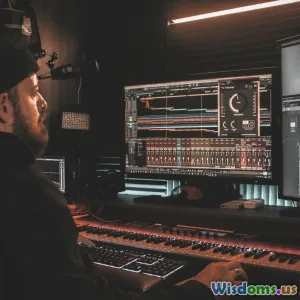
A Beginner’s Guide to Understanding Different House Music Subgenres
10 min read Explore a thorough beginner's guide to house music's vibrant subgenres with examples and real-world insights for a deeper appreciation. (0 Reviews)
A Beginner’s Guide to Understanding Different House Music Subgenres
House music is more than just a genre; it’s a cultural phenomenon that has influenced dance floors worldwide since the early 1980s. If you’ve ever found yourself drawn to pulsating rhythms and infectious beats but felt overwhelmed by the myriad styles labeled under "house," you're not alone. This guide peels back the layers of house music's diverse subgenres, making it approachable and exciting for beginners.
Introduction: What Exactly Is House Music?
Emerging from Chicago’s underground club scene in the early 1980s, house music combines the hypnotic beats of disco, the raw edge of electronic experimentation, and the soul of the city’s nightlife. Typically characterized by a 4/4 beat, synthesized basslines, repetitive rhythms, and soulful vocals, house laid the foundation for countless artists and DJs across the globe.
However, house music has evolved dramatically since its origins. Its energy and innovation gave rise to numerous subgenres, each with its unique flavor and audience. Understanding these styles opens up a richer listening experience and enhances your appreciation of the art form.
Deep House: Soulful and Sophisticated
Origins and Characteristics
Deep House emerged in the mid-1980s, heavily influenced by Chicago house pioneers like Larry Heard (a.k.a. Mr. Fingers). It features slower tempos (usually between 110-125 BPM), soft synths, subtle melodies, and often combines jazzy, soulful, or funky elements.
Exemplary Tracks and Artists
- Larry Heard – "Can You Feel It" (1986): An atmospheric track with emotive chords that perfectly captures deep house’s essence.
- Kerri Chandler: An icon known for keeping deep house rooted in soulful storytelling.
- Disclosure: Modern ambassadors bringing deep house elements to the mainstream.
Why It Matters
Deep House appeals to listeners looking for an emotional connection beyond the club’s frenzied pace. It often provides the perfect soundtrack for chilled evenings or sophisticated dance venues.
Tech House: When Techno Meets House
What Defines Tech House?
Tech House blends the groove of house with the crisp, minimal textures of techno. Expect a danceable, upbeat rhythm with synthetic basslines, repetitive hi-hats, and focused, often stripped-down production.
Origins
Growing strongly in the early 2000s, Tech House rose as a favored genre for DJs seeking to keep the energy high without venturing into aggressive techno or overly pop-inflected house.
Notable Artists
- Carl Cox: Often credited for popularizing Tech House with his relentless club sets.
- Green Velvet: Known for combining quirky vocal chops and techno beats.
- Hot Since 82: A modern stalwart pushing the genre forward.
Real-World Impact
Tech House is ubiquitous in festival main stages and boutique events alike, connecting underground sensibilities with large audience appeal.
Acid House: The Psychedelic Pioneer
Defining the Acid Sound
Acid House is instantly recognizable by its squelchy, resonant bassline produced using the Roland TB-303 synthesizer. Born in Chicago in the mid-1980s, Acid House brought a psychedelic, experimental vibe to dance music.
Historical Context
Initially embraced by warehouse parties, Acid House symbolized counterculture and the rave revolution.
Key Tracks and Figures
- Phuture – "Acid Tracks" (1987): Often labeled the first acid house record.
- DJ Pierre: One of the key figures behind the TB-303 sound.
Modern Influence
The acid sound has seen several revivals, influencing genres like techno, trance, and even pop music.
Progressive House: The Storyteller
The Progressive Journey
Progressive House distinguishes itself with evolving soundscapes, build-ups, and often cinematic qualities. It’s less about intense peaks and more about sustained emotional progression.
Tempo and Sound
Typically sits between 125-130 BPM, incorporating melodic chord progressions with extended, layered arrangements.
Influential Artists
- Sasha & John Digweed: Groundbreaking DJs and producers credited with popularizing progressive house.
- Eric Prydz: Known for his evocative and layered production style.
Why It Stands Out
For beginners, progressive house offers a more relaxed but emotionally charged entry point, perfect for listeners who like musical narratives in dance music.
Funky House: Groove and Vibrancy
Groove-Centric Focus
Funky House brings groove-driven basslines, catchy melodies, and often samples from disco and funk hits. It’s upbeat, lively, and designed to keep people moving.
Evolution and Popularity
Often popular on commercial radio and dance charts, artists infuse organic instruments and recognizable hooks, creating tracks with mass appeal.
Examples
- Basement Jaxx: Known for their playful, upbeat funky house tracks.
- Joey Negro: A key figure layering funk and soulful rhythms.
The Dancefloor Appeal
It remains a staple in club nights that want to maintain an accessible yet energetic mood.
Chicago House and Its Legacy
The Roots
Chicago house is the primal wellspring of all house music subgenres. Characterized by repetitive 4/4 beats, use of drum machines (like the Roland TR-808 and TR-909), and soulful vocals, it set the groundwork with underground appeal.
Cultural Impact
Beyond music, Chicago house inspired fashion, dance styles (like the Shuffle), and even social communities embracing inclusivity and freedom.
Legendary Artists
- Frankie Knuckles: “Godfather of House Music.”
- Marshall Jefferson: Known for "Move Your Body," a quintessential Chicago house anthem.
Exploring Vocal House
Emotions in Lyrics
Vocal House emphasizes soulful singing, often borrowing gospel or R&B influences. The vocals usually carry uplifting messages or seductive grooves.
Impact on Popularity
It helped bridge underground house with mainstream audiences, with classic records reaching charts worldwide.
Notable Songs
- CeCe Peniston – "Finally": A dance anthem known for its infectious vocal hooks.
- Robin S. – "Show Me Love": A timeless vocal house staple.
Why Know House Subgenres?
Understanding subgenres enriches your experience whether you’re a casual listener, aspiring DJ, or music producer. Each style offers distinct emotions and contexts—from the soulful depths of Deep House to the experimental twists of Acid House.
Moreover, recognizing these differences can open doors to discovering labels, festivals, and communities tailored to specific tastes.
Conclusion: Embrace the Dancefloor’s Diversity
House music is a multi-faceted universe with a rich history and evolving present. For beginners, diving into subgenres reveals not only different sounds but cultural stories and movements.
With this guide, start listening actively: pinpoint the groovy basslines of Funky House, feel the hypnotic progression of Progressive House, trace Acid House’s rebellious spirit, or get lost in the emotion-filled vibes of Deep and Vocal House. Whether exploring through iconic tracks, DJ sets, or curated playlists, the journey through house subgenres can be as rhythmic and captivating as the music itself.
Happy listening — may your exploration of house music bring newfound joy and dance-floor inspiration.
References & Further Listening:
- Larry Heard - “Can You Feel It”
- Phuture - “Acid Tracks”
- Frankie Knuckles - “Your Love”
- Basement Jaxx - “Where’s Your Head At?”
- Disclosure - “Latch” featuring Sam Smith
- Sasha & John Digweed - Various progressive house sets
Exploring curated Spotify and Beatport playlists can also be a great way to immerse yourself.
Disclaimer: This guide aims to give a beginner-friendly overview, but house music’s scope and regional variants may offer even deeper layers worth exploring.
Rate the Post
User Reviews
Popular Posts















